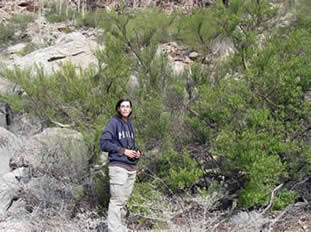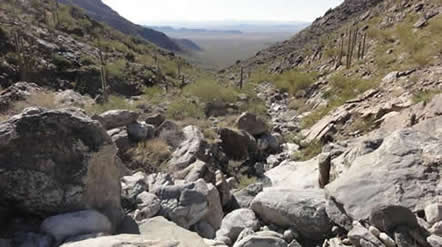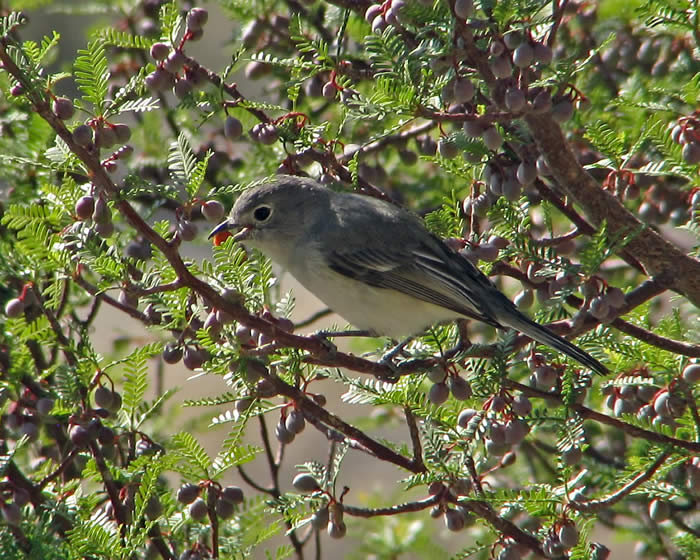 |
 |
|||||||||||||||||||||
|
||||||||||||||||||||||
Gray Vireo Surveys in Southwestern Arizona
AZFO Field Expedition Summary
December 3-4, 2011
John Arnett, Wildlife Biologist, Luke AFB, 56RMO
(an interim summary is presented here with a full expedition report coming soon)
On behalf of John Yerger and Troy Corman, I want to thank the 19 intrepid participants of the recent (December 3-4, 2011) and very successful Arizona Field Ornithologists (AZFO) Field Expedition to find wintering Gray Vireos: Joey Alsadi, John Arnett, Carol Beardmore, Greg Clark, Troy Corman, Pierre Deviche and Dany Pierard-Deviche, Lauren Harter, Tim Helentjaris, Melanie Hoffman, Edwin Juarez, Chrissy Kondrat-Smith, Mark Larson, Tom Lewis, Jennie MacFarland, Tim Price, David Vander Pluym, and Bob and Janet Witzeman. Thank you for hiking up and down precarious rocky slopes (no injuries were reported, thankfully), for learning and conducting meticulous bird survey and habitat measurement protocols, and for enduring a morning spent outside in particularly lovely weather.
 |
 |
| Bursera microphylla (L. Harter, foreground) | Gray Vireo wintering habitat: steep rocky slopes with Bursera |
| Photo: David Vander Pluym | Photo: John Arnett |
The main objective of this Field Expedition was to improve our understanding of where Gray Vireos over-winter at the eastern and northern periphery of the range of elephant trees (Bursera microphylla) in Arizona. Our three specific goals were to (1) visit known localities and find new populations of elephant trees, (2) search for Gray Vireos among and near elephant trees using a call-broadcast survey method, and (3) collect basic habitat and vegetation data that may correlate with Gray Vireo presence/ absence. I also hoped that all involved would have fun and enjoy visiting some of Arizona’s rugged and remote nooks and crannies.
Well, we certainly achieved our main objective! Here are some of the exciting, initial results:
In La Paz County, David Vander Pluym and Lauren Harter found a Gray Vireo near Socorro Peak, at the western
end of the Harquahala Mountains. As David recently wrote online, this may be the first record for Gray Vireo in these mountains. Decades may have passed since the last time a Gray Vireo was found during the early- or mid-winter anywhere in La Paz County. Also, David and Lauren may have found new elephant tree sites at the Harquahala Mts. that could be checked for vireos in the future.
In Maricopa County, Chrissy Kondrat-Smith and Melanie Hoffman found a Gray Vireo at the White Tank Mountains,
just west of Phoenix. This is probably the first Gray Vireo winter (or any season?) record for these mountains. Moreover, Chrissy and Melanie found several new areas of elephant trees and reported the trees were surprisingly numerous;
this is exciting potential for future survey efforts. Also in Maricopa County, Troy Corman, Joey Alsadi, Tom Lewis and I surveyed several large canyons on the western side of the Sierra Estrella. We found 5 to 6 Gray Vireos among the abundant, cacophonous Ash-throated Flycatchers. Again, these are probably the first Gray Vireo winter records for these mountains. Based on my reconnaissance in early 2010 I suspected Gray Vireos would occur at Sierra Estrella, and now we have confirmation!
To top it off, Dr. Pierre Deviche took this stunning photograph of a Gray Vireo with a ripe elephant tree fruit in its bill! That might be a first; we’ll have to check with John Bates and others who have studied these species:
 |
| Gray Vireo eating Bursera fruit! |
| Photo: Pierre Deviche |
Elephant tree fruit is clearly an important winter food for Gray Vireos and perhaps other species (i.e., Ash-throated Flycatcher) in Arizona. As we learn more about these species, more questions arise. It is well known that elephant trees are sensitive to cold temperatures. AZFO Expedition teams in the Waterman Mountains (Tim Helentjaris, Jennie MacFarland) and Sierra Estrella (Troy Corman, John Arnett) reported elephant trees that appeared dead or seriously reduced in vigor. We suspect this was caused by prolonged freezing temperatures near Tucson and at other areas above 2200’ during January and February 2010. What is less known is that elephant trees may also be susceptible to drought and excessive heat. In early 2010, AZGFD biologist Lin Piest, a group of interns, and I observed many dead elephant trees on the western slopes of mountain ranges in extreme southwestern Arizona. The suspected cause was a combination of drought and prolonged excessive heat, particularly during 2006. This was surprising because elephant trees are reported to thrive on sun-drenched, west-facing slopes. Thus, if elephant trees are susceptible to both frost and heat/drought, how might climate change and increased climatic variability affect elephant trees and, as a result, the distribution of Gray Vireos? We have much more to learn, and I hope Arizona’s community of bird and nature enthusiasts will continue to show an interest in these species.
| Gray Vireo wintering habitat close-up | Bursera fruit close-up | |
| Photo: Troy Corman | Photo: John Arnett |
 |
| Freeze damage on young elephant tree |
| Photo: Troy Corman |
This type of effort does not get off the ground, nor would it be such a tremendous success, without the existence of AZFO – an exciting assembly of birders, scientists, natural resource managers, sardonic sesquipedalians (John Yerger), and others. It was a pleasure coordinating this AZFO Field Expedition and working with you all, and I hope everyone involved gained a better appreciation of elephant trees and Gray Vireos.
Sincerely,
John Arnett
Wildlife Biologist, Luke AFB, 56RMO; john.arnett AT luke.af.mil
Secretary, Sonoran Audubon Society
AZ Representative, DoD Partners In Flight
|
©2005
|
HOME | | | REPORT SIGHTINGS | | | PHOTOS | | | BIRDING | | | JOURNAL | | | ABOUT US | | | CHECKLISTS | | | AZ BIRD COMMITTEE | | | EVENTS | | | LINKS |